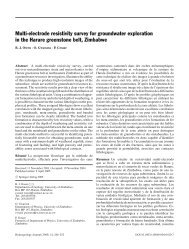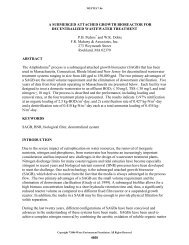Species diversity in the Florida Everglades, USA - Environmental ...
Species diversity in the Florida Everglades, USA - Environmental ...
Species diversity in the Florida Everglades, USA - Environmental ...
Create successful ePaper yourself
Turn your PDF publications into a flip-book with our unique Google optimized e-Paper software.
256 M. T. Brown et al. Ecosystem bio<strong>diversity</strong> <strong>in</strong> <strong>the</strong> <strong>Florida</strong> <strong>Everglades</strong><br />
Ra<strong>in</strong>fall (cm)<br />
30<br />
25<br />
20<br />
15<br />
10<br />
5<br />
0<br />
Average Ra<strong>in</strong>fall<br />
J F M A M J J A S O N D<br />
Month<br />
Figure 2. Average monthly ra<strong>in</strong>fall (1961–1990) <strong>in</strong> <strong>the</strong> central <strong>Everglades</strong><br />
(Fernald and Purdum, 1998).<br />
<strong>the</strong> result of frontal activity. Ra<strong>in</strong>fall is highly variable<br />
both from season to season and year to year, often punctuated<br />
by very dry years correspond<strong>in</strong>g to El Niño events<br />
and hurricanes that can br<strong>in</strong>g as much as 50 cm of ra<strong>in</strong>fall<br />
<strong>in</strong> a short period of time (Fernald and Purdum, 1998).<br />
The historic <strong>Everglades</strong> system. The historic <strong>Everglades</strong><br />
was a wide arch<strong>in</strong>g, sawgrass (Cladium jamaicense)<br />
dom<strong>in</strong>ated “River of Grass” (Douglas, 1947), centrally<br />
located with<strong>in</strong> <strong>the</strong> sou<strong>the</strong>rn portion of <strong>the</strong> <strong>Florida</strong> pen<strong>in</strong>sula<br />
(Fig. 1). The <strong>Everglades</strong> “River of Grass” covered<br />
approximately 10,100 km 2 and was <strong>the</strong> lower segment of<br />
a much larger dra<strong>in</strong>age system (<strong>the</strong> Greater <strong>Everglades</strong><br />
watershed) of approximately 23,300 km 2 (Gleason and<br />
Stone, 1994) stretch<strong>in</strong>g about 350 km from central <strong>Florida</strong><br />
to <strong>the</strong> sou<strong>the</strong>rn tip at <strong>Florida</strong> Bay. The sou<strong>the</strong>rn region<br />
of <strong>the</strong> <strong>Everglades</strong> had nearly imperceptible slope from<br />
Lake Okeechobee southward to <strong>Florida</strong> Bay, averag<strong>in</strong>g<br />
around 3 cm/km. On <strong>the</strong> east, <strong>the</strong> <strong>Everglades</strong> was bounded<br />
by a low sand-covered limestone ridge dom<strong>in</strong>ated by<br />
p<strong>in</strong>e and tropical hardwood forests known as <strong>the</strong> Atlantic<br />
Coastal Ridge. The ridge was approximately 8–10 km <strong>in</strong><br />
width with elevations averag<strong>in</strong>g less than 10 m, and was<br />
breached <strong>in</strong> numerous locations by dra<strong>in</strong>age ways carry<strong>in</strong>g<br />
ra<strong>in</strong>y season waters eastward to <strong>the</strong> Atlantic Ocean.<br />
To <strong>the</strong> west was <strong>the</strong> region known as <strong>the</strong> “Big Cypress<br />
Swamp”, presumably named because of <strong>the</strong> dom<strong>in</strong>ance<br />
of cypress trees (Taxodium spp.) <strong>in</strong>termixed with sawgrass<br />
prairies. As Figure 1 suggests, <strong>the</strong> Big Cypress<br />
Swamp area was a separate hydrologic unit from <strong>the</strong> <strong>Everglades</strong><br />
except dur<strong>in</strong>g extremely wet years when waters<br />
may have fl owed from one system to <strong>the</strong> o<strong>the</strong>r <strong>in</strong> ei<strong>the</strong>r<br />
direction.<br />
To <strong>the</strong> north of <strong>the</strong> <strong>Everglades</strong>, Lake Okeechobee<br />
(surface area = 1,732 km 2 ) received surface <strong>in</strong>fl ows from<br />
a dra<strong>in</strong>age area of about 9,600 km 2 that extended from <strong>the</strong><br />
central <strong>Florida</strong> highlands through a dra<strong>in</strong>age way dom<strong>in</strong>ated<br />
by nearly level marshy wetlands and <strong>the</strong> meander<strong>in</strong>g<br />
Kissimmee River (SFWMD, n.d.). The Lake was<br />
hydrologically connected to <strong>the</strong> <strong>Everglades</strong> and as lake<br />
levels rose <strong>in</strong> response to wet season ra<strong>in</strong>s, lake water<br />
would over-top <strong>the</strong> natural levee on its sou<strong>the</strong>rn shore<br />
and sheet fl ow <strong>in</strong>to <strong>the</strong> river of grass. Parker (1974) suggested<br />
that <strong>the</strong> tim<strong>in</strong>g of water levels <strong>in</strong> <strong>the</strong> overall Kissimmee-<strong>Everglades</strong><br />
system was such that as <strong>the</strong> dry season<br />
approached <strong>in</strong> South <strong>Florida</strong>, <strong>the</strong> previous wet season<br />
ra<strong>in</strong>s <strong>in</strong> <strong>the</strong> nor<strong>the</strong>rn portions of <strong>the</strong> bas<strong>in</strong> were just arriv<strong>in</strong>g<br />
<strong>in</strong> Lake Okeechobee, which would <strong>the</strong>n over-top <strong>the</strong><br />
sou<strong>the</strong>rn levee and sheet-fl ow <strong>in</strong>to <strong>the</strong> <strong>Everglades</strong> ma<strong>in</strong>ta<strong>in</strong><strong>in</strong>g<br />
water levels through <strong>the</strong> dry season.<br />
The water that sheet-fl owed across <strong>the</strong> <strong>Everglades</strong><br />
was derived primarily from ra<strong>in</strong>fall and thus was very<br />
low <strong>in</strong> nutrients. Nutrients from upland areas that entered<br />
<strong>the</strong> system <strong>in</strong> runoff were quickly taken up by vegetation<br />
or immobilized by soils. The result was that vast expanses<br />
of <strong>the</strong> <strong>Everglades</strong> were considered oligotrophic<br />
(nutrient poor) wetlands that developed under conditions<br />
of severe phosphorus (P) limitation (McCormick et al.,<br />
1998).<br />
The <strong>Everglades</strong> system functioned as an <strong>in</strong>terconnected<br />
mosaic of wetland habitats <strong>in</strong>terspersed with seasonally<br />
saturated “tree islands” and p<strong>in</strong>elands, cover<strong>in</strong>g<br />
nearly 90 % of sou<strong>the</strong>rn <strong>Florida</strong> (Odum and Brown,<br />
1975). M<strong>in</strong>or variation <strong>in</strong> topography created a highly<br />
heterogeneous landscape mosaic and <strong>in</strong>fl uenced <strong>the</strong> <strong>diversity</strong><br />
of both fl ora and fauna. The alternat<strong>in</strong>g periods of<br />
wet and dry seasons regulated <strong>the</strong> life cycles of animal<br />
populations, while depths and duration of <strong>in</strong>undation result<strong>in</strong>g<br />
from <strong>the</strong> vary<strong>in</strong>g topography regulated primary<br />
production.<br />
The <strong>Everglades</strong> system today. The <strong>Everglades</strong> of today<br />
bears little resemblance to <strong>the</strong> historic system. The spatial<br />
extent of <strong>the</strong> orig<strong>in</strong>al <strong>Everglades</strong> has been reduced<br />
by approximately 50 % (Fig. 3). Over 4,000 km 2 of <strong>the</strong><br />
<strong>Everglades</strong> south of Lake Okeechobee have been converted<br />
to agricultural lands. Areas along <strong>the</strong> eastern<br />
edge of <strong>the</strong> <strong>Everglades</strong> have been converted to various<br />
urban uses, <strong>in</strong>clud<strong>in</strong>g rock quarries, commercial and<br />
residential development, and agriculture. In all, approximately<br />
12,000 km 2 of <strong>the</strong> orig<strong>in</strong>al Greater <strong>Everglades</strong><br />
(<strong>in</strong>clud<strong>in</strong>g <strong>the</strong> Kissimmee River watershed) have<br />
been converted to human uses (<strong>USA</strong>CE and SFWMD,<br />
1999).<br />
Surrounded by developed lands and crisscrossed by<br />
roads, canals, and dikes, water no longer fl ows unobstructed<br />
from Lake Okeechobee to <strong>the</strong> <strong>Florida</strong> Bay and<br />
<strong>the</strong> Gulf of Mexico. Instead, water fl ow is highly managed<br />
through a series of canals, locks, and pumps which<br />
direct it to controlled Water Conservation Areas (WCA),<br />
thus alter<strong>in</strong>g <strong>the</strong> basic fl ows and storages of water and
















